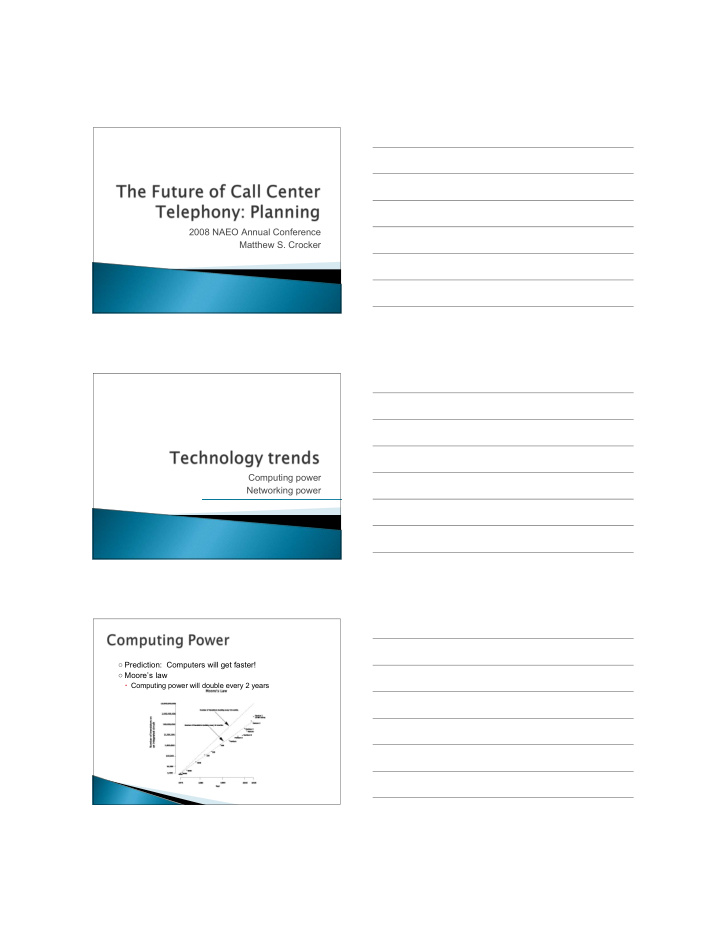



2008 NAEO Annual Conference Matthew S. Crocker Computing power Networking power ◦ Prediction: Computers will get faster! ◦ Moore’s law Computing power will double every 2 years
Virtualization CPU power is wasted, sitting idle, eating power Virtualization runs multiple virtual machines on the same hardware, increasing efficiency, Security & Reliability ◦ VMWare ◦ Citrix (XenServer) ◦ Microsoft Virtualization Server Prediction: Networks will get faster! All communications can be broken down into three types of networks ◦ Broadcast networks (radio, television) P=N ◦ Point to Point networks (PSTN) P=N^2 ◦ Point to multi-point Networks (Internet) P=2^N
Using the power of the Internet for all applications. Spend your money making your Internet connection fast and reliable. ◦ EoIP ◦ MPLS ◦ SaaS ◦ VoIP Everything over IP ◦ All applications will migrate to IP technologies Backup Disaster Recovery Business Continuity Credit card processing Paging Multi-Protocol Label Switching ◦ High performance network infrastructure able to provide QoS, Security, Survivability, Reliability ◦ Based on IP Technology ◦ All major national/global carriers operate MPLS networks. ◦ The ‘Internet’ is a virtual network running over an MPLS core. ◦ Allows carriers to provide Differential Services to replace legacy applications (ATM, Frame Relay …)
Software As A Service ◦ Web based technologyallows hosting providers to deliver desktop applications over the Internet Google NetSuite Salesforce.com Microsoft& Yahoo! ◦ Let the hosting company deal with backup, disaster recovery, development Voice is an application Voice over Internet Protocol ◦ NOT equal to Voice over the Internet ◦ VoIP is free of geographic limitations TNs can be anywhere ◦ QoS – REQUIRED (avoid the Internet) ◦ Signalling – SIP ,MGCP, H.323 ◦ Codecs – g.711u, g.729 TDM is dead E-mail is dying VoIP has massive growth potential SMS ‘Texting’ & IM replacing voice
SIP Interface for Infinity VoIP enabled voice-logger Switching operator stations to VoIP ◦ Softphonew/USB headset Replacing PRIs with VoIP SPAM Unreliable Insecure Convert to web based services for message pickup & delivery (IS) using SSL ◦ Confirmed message pickup ◦ Makes customers ‘sticky’ Hosted messaging – new business opportunity (SaaS) Bandwidth, bandwidth, bandwidth ◦ QoS is required but does not create bandwidth ◦ High speed, low latency, LOW JITTER!!!! N+1 for IP connectivity ◦ Symmetrical service (no DSL) ◦ 80kbps per g.711u call ◦ 20kbps per g.729a call
Teenagers text more than they talk ◦ They will be our customers customer in the next 5-10 years ◦ How will you handle the communications needs of your customers in the future? ◦ SMS -> Message that can be acted on ◦ Instant Messaging We have an opportunity to provide additional communications services for our customers. Makes our customers ‘Sticky’ Low Capex, outsource to hosting providers ◦ We become the aggregator, wholesaler, integrator of our customers communications needs. Questions?
Quality of Service ◦ It is all about QoS DSCP aka DiffServ. ◦ The Internet doesn’t support QoS ◦ MPLS does support QoS ◦ QoS is an end-to-end solution, all devices must support QoS in order for it to work. ◦ Latency (how long does it take) ◦ Jitter (How often does Latency change?) ◦ High Latency is ‘ok’, high Jitter is BAD! Differentiated Services Code Point ◦ Part of an IP packet header (Express mail) ◦ Packets are marked with DSCP at the end points ◦ DSCP is checked at every router/switch in the path ◦ Routers/Switches use DSCP to select queues for packet processing. Express lane for high priority traffic ◦ QoS needs to be configured on EVERY device in the path, it is NOT on by default G.711u – same 64kbps as TDM but packetized. High quality, high bandwidth codec – 80kbps per call G.729 – compressed, low bandwidth, high CPU requirements, licensing fees – 20kbps per call T.38 – Faxing over IP
Session Initiation Protocol (SIP) SIP has won the battle. MGCP, Megaco, SCCP (skinny), H.323, H.248 Signaling is what does call setup and teardown – Similar to ISDN-PRI (q.931) Asterisk is an open source VoIP PBX/switch/Voicemail/IVR application Runs on Linux
Recommend
More recommend